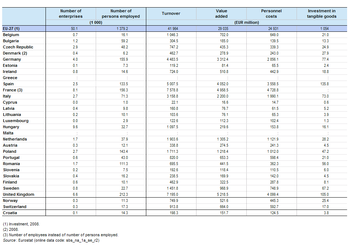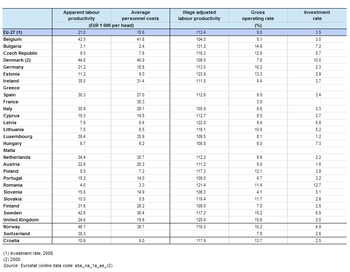Archive:Security and investigation services statistics - NACE Rev. 2
- Data from April 2012. Most recent data: Further Eurostat information, Main tables and Database.
This article presents an overview of statistics for the security and investigation services sector in the European Union (EU), as covered by NACE Rev. 2 Division 80.


(% share of sectoral total) - Source: Eurostat (sbs_na_1a_se_r2)





Main statistical findings
Structural profile
There were around 50 thousand enterprises operating within the security and investigation services (Division 80) sector in the EU-27 in 2009. They employed 1.38 million persons, which was equivalent to 1.0 % of the total workforce within the non-financial business economy (Sections B to J and L to N and Division 95) or slightly more than one in ten (11.5%) of those employed in administrative and support services (Section N). EU-27 security and investigation services enterprises generated EUR 29 035 million of value added which was 0.5 % of the non-financial business economy total or 8.3 % of the administrative and support services total.
The apparent labour productivity of the EU-27's security and investigation services sector in 2009 was EUR 21 thousand of value added per person employed, which was almost half the non-financial business economy average (EUR 41.6 thousand) and some EUR 8 thousand below the administrative and support services average. As such, the security and investigation services sector recorded the fourth lowest level of apparent labour productivity among all of the NACE divisions that make-up the non-financial business economy.
Alongside this very low level of apparent labour productivity, average personnel costs within the EU-27’s security and investigation services sector were also relatively low at EUR 18.6 thousand per employee in 2009, some EUR 11.4 thousand below the average for the non-financial business economy and EUR 2.3 thousand lower than the average for administrative and support services. EU-27 average personnel costs for the security and investigation services sector were the fifth lowest across all of the NACE divisions within the non-financial business economy.
The wage-adjusted labour productivity ratio combines the two previous indicators and shows the extent to which value added per person employed covers average personnel costs per employee. With both of these indicators being very low they largely cancelled out a large part of the differences when compared to benchmark values such as those for the non-financial business economy. However, with apparent labour productivity being proportionally lower than average personnel costs this resulted in wage-adjusted labour productivity for the EU-27’s security and investigation services sector of 113.4 %, somewhat inferior to the non-financial business economy average (138.8 %) or the administrative and support services average (139.1 %).
The gross operating rate (the relation between the gross operating surplus and turnover) is one measure of operating profitability; it stood at 9.6 % for the EU-27’s security and investigation services sector in 2009, which was broadly in line with the non-financial business economy average (9.7 %), but lower than the administrative and support services average (15.2 %).
Sectoral analysis
Around seven in every ten enterprises within the EU-27’s security and investigation services sector were classified as operating within the private security activities (Group 80.1) subsector, while around one in six were in the security systems service activities subsector (Group 80.2), leaving the residual engaged in investigation activities (Group 80.3).
In terms of output and persons employed, the relative importance of private security activities was more pronounced, as this subsector accounted for 87.4 % of sectoral value added and for 87.5 % of the sectoral workforce. The majority of the remainder was accounted for by the security systems service activities subsector, with an 11.2 % share of added value and a 10.7 % share of the workforce. Investigation activities accounted for less than 2 % of sectoral value added or employment.
The low apparent labour productivity figure for the whole of the security and investigation services sector was a pattern repeated across all three subsectors, as this ratio ranged from a high of EUR 22 thousand of added value per person employed for the EU-27’s security systems service activities subsector to a low of EUR 17 thousand per person employed for investigation activities; the latter was the fifth lowest level of apparent productivity among any of the NACE groups that constitute the non-financial business economy.
Average personnel costs mirrored the pattern for apparent labour productivity insofar as they were consistently well below the non-financial business economy average for all three security and investigation services subsectors, while the lowest level of EU-27 average personnel costs was recorded for investigation activities (EUR 12.8 thousand per employee in 2009); this latter figure was the second lowest level of average personnel costs per employee for any of the NACE groups that make-up the non-financial business economy.
All three security and investigation services subsectors also reported EU-27 wage-adjusted labour productivity ratios in 2009 that were below the non-financial business economy average of 138.8 %. These ranged from 129.5 % for investigation activities down to 112.1 % for the largest subsector, private security activities.
There were wider differences between the three subsectors in relation to their gross operating rates. This lowest operating profitability rate (using this measure) was recorded for the EU-27’s private security activities subsector, at 9.2 % in 2009. This was also the only subsector where the gross operating rate was below the non-financial business economy average (9.7 %). In contrast, operating profitability rose to 12.2 % for security systems service activities and peaked at 18.6 % (almost double the non-financial business economy average) for investigation activities.
Country analysis
The United Kingdom accounted for an 18.0 % share of EU-27 value added within the security and investigation services sector in 2009. The United Kingdom also recorded the highest share of EU-27 added value for the private security activities subsector (19.7 %), while France had the biggest share of the security systems service activities subsector (21.1 %) and Germany for the investigation activities subsector (20.7 %).
In relative terms, the value added generated by the security and investigation services sector in 2009 accounted for 1.2 % of non-financial business economy added value in Estonia, the highest share among those Member States for which data are available; Bulgaria, Latvia and Romania all reported shares of at least 1.0 %. At the other end of the range, the least specialised Member States in relation to the security and investigation services sector included Denmark, Cyprus and Austria, where this activity generated no more than 0.2 % of value added within the whole of the non-financial business economy.
The United Kingdom was also the leading employer within the security and investigation services sector, as its workforce of 212.3 thousand persons was equivalent to almost one in six (15.4 %) of the EU-27 total in 2009, followed by France (note that the data relate to employees and not persons employed), Germany and Poland; these three Member States each had a workforce of more than 140 thousand persons.
All of the Member States for which data are available in 2009 reported wage-adjusted labour productivity ratios for security and investigation services that were above 100 %. However, none of the Member States recorded wage-adjusted labour productivity ratios for the security and investigation services sector that were higher than their respective non-financial business economy averages. The highest wage-adjusted labour productivity ratios were recorded in Bulgaria (131.2 %), the United Kingdom, Estonia and Latvia – the latter three countries all had ratios between 125.4 % and 122.8 %.
For the gross operating rate there was a wider range of values, with just under half of the Member States for which data are available reporting that they had a higher profitability rate for security and investigation services than they did for their respective non-financial business economies. This was most evident in Sweden where the gross operating rate for security and investigation services reached 15.2 %, some 6.6 percentage points higher than the Swedish non-financial business economy average. The United Kingdom reported a higher gross operating rate (15.6 %) but this figure was just 2.6 percentage points higher than the non-financial business economy average. In contrast, the lowest gross operating rate was recorded in France (3.0 %), compared with a non-financial business economy average of 6.4 %.
Data sources and availability
The analysis presented in this article is based on the main dataset for structural business statistics (SBS) which are disseminated annually. The series provides information for each Member State as well as a number of non-member countries at a detailed level according to the activity classification NACE. Data are available for a wide range of variables.
Context
This article presents an overview of statistics for the security and investigation services sector in the EU, as covered by NACE Rev. 2 Division 80. It includes security-related services such as private security services, security systems services and investigation activities. Private security activities include the provision of guard and patrol services, protected pick-up, transit and delivery of valuable items (including money), bodyguard services and fingerprinting services. Security systems service activities include monitoring of electronic security alarm systems (such as burglar and fire alarms) including their installation and maintenance. Also included are installing, repairing, rebuilding, and adjusting mechanical or electronic locking devices, safes and security vaults in connection with later monitoring and remote monitoring. Investigation activities include investigation and detective services regardless of the type of client or purpose of investigation.
This NACE division is composed of three groups:
- private security activities (Group 80.1);
- security systems service activities (Group 80.2);
- investigation activities (Group 80.3).
Public order and safety activities, which form part of public administration and defence; compulsory social security (Division 84) are excluded, as are the installation or sale of security systems without later monitoring – which form part of specialised construction activities (Division 43) and retail trade (Division 47). Also excluded are services of security consultants, which from part of other professional, scientific and technical activities (Division 74).
Further Eurostat information
Publications
Main tables
Database
- SBS – services (sbs_serv)
- Annual detailed enterprise statistics - services (sbs_na_serv)
- Annual detailed enterprise statistics for services (NACE Rev.2 H-N and S95) (sbs_na_1a_se_r2)
- Preliminary results on services, main indicators (NACE Rev.2) (sbs_sc_r2preli)
- SMEs - Annual enterprise statistics broken down by size classes - services (sbs_sc_sc)
- Services broken down by employment size classes (NACE Rev.2 H-N and S95) (sbs_sc_1b_se_r2)
- Annual detailed enterprise statistics - services (sbs_na_serv)
- SBS - regional data - all activities (sbs_r)
- SBS data by NUTS 2 regions and NACE Rev.2, from 2008 onwards (sbs_r_nuts06_r2)
Dedicated section
Source data for tables, figures and maps (MS Excel)
Other information
- Regulation 58/1997 of 20 December 1996 concerning structural business statistics
- Decision 2367/2002/EC of 16 December 2002 on the Community statistical programme 2003 to 2007
- Regulation 295/2008 of 11 March 2008 concerning structural business statistics